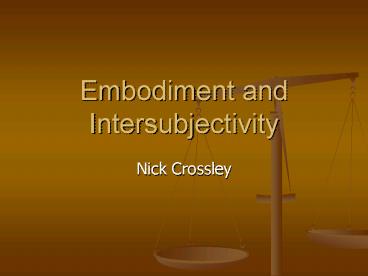Embodiment and Intersubjectivity - PowerPoint PPT Presentation
1 / 13
Title:
Embodiment and Intersubjectivity
Description:
Husserl: Analogical Apperception. Apperception: perceiving more than we actually see: e.g. ... Husserl Analogical apperception (2) I pair' other with self. ... – PowerPoint PPT presentation
Number of Views:1498
Avg rating:3.0/5.0
Title: Embodiment and Intersubjectivity
1
Embodiment and Intersubjectivity
- Nick Crossley
2
The body was at the centre of the classical
philosophical formulation of the problem of
intersubjectivity
- Mind and body are distinct.
- Body is perceivable from outside, by (external)
perception. - Mind (subjectivity) isnt. Mind is only knowable
through introspection. - How do I know that your body contains a mind?
- How do I know what you are thinking?
- Your body is my only clue but its only a clue.
3
This might be a questionable starting point but
it highlights the corporeal nature of the social
world.
- Face-to-face is just that.
- The interaction that generates the social world
is necessarily and irreducibly embodied. - And intersubjectivity must hinge upon embodiment
(unless its telepathy!). - Intersubjectivity rests upon intercorporeality
(Merleau-Ponty). - The social world presupposes an intercorporeal
foundation.
4
Solutions
- Many solutions rest upon the notion of analogy
- Your body looks like mine.
- It behaves like mine.
- My body contains a mind.
- So perhaps your does too.
5
Husserl Analogical Apperception
- Apperception perceiving more than we actually
see e.g. backs of houses, weight of heavy
objects etc. - Works by habitus and pairing
(typification) e.g. this computer with my own. - Problem- Ive never seen anothers consciousness
so what do I pair with?
6
Husserl Analogical apperception (2)
- I pair other with self.
- Even in the absence of intersubjective relations
I know my own mind (my spehre of ownness). - E.g. I know what pain feels like, so when I see
you behaving as I behave when I am in pain in
project my pain experriences onto you.
7
But
- This presupposes mind/body dualism embodied
behaviour as a signal of mental states which
belong to another realm. - I cant see much of my own behaviour (esp. my
face). - My sense of what is mine already presupposes
the perspective of the other and thus
intersubjectivity. - If subjectivity was truly private and disembodied
there would be no words (in a shared language) to
describe it. - Etc.
8
We need an alternative approach (using Mead,
Merleau-Ponty, Wittgenstein, Ryle)
- Behaviour is not an external expression of events
in a disembodied mental realm. - To be meaningful embodied behaviour must be
embedded in shared forms of life. - We learn, socially, to ascribe mental states to
ourselves, based upon public criteria. - Our sense of self and other are achieved
coterminously, in interaction (play/games). - Etc.
9
Underlying this is embodied interaction
(intercorporeality)
- A conversation of gestures.
- An embodied grasp upon (the role of) the other.
- An embodied grasp of the games of the social
world, esp. language games.
10
Empathy is embodied
- You drop a weight on your toe and I cringe.
- You walk a tightrope and I wobble.
- I finish your sentences.
- I feel shame, pride, guilt in your presence.
- I feel you looking at me.
11
However, even if our subjectivity is embodied and
thus public in principle (philosophically)
- Experience is privatised in modern societies
(Elias). - There are norms of acceptable expression/disclosur
e. - And it is strategically advantageous to control
information flow (Goffman). - We learn to keep secrets, control our expression,
lie and present self
12
Perhaps social life requires it
- Some interactions are functionally specific the
bus driver doesnt need to know my life story and
doesnt want to know. - Relations presuppose repulsion/distance as well
as attraction/proximity (Simmel) - Even romantic attachments are only kept
excitement through the gaps that allow for
imaginative projection and hide and seek.
(Simmel). - But in cases akin to the latter this generates a
tension (and that is the point)
13
So the problem of intersubjectivity comes back in
a sociological form
- The body of the other reveals but perhaps only
what they want it reveal e.g. in emotional
labour. - The body of the other tells two stories
(Bateson/double bind). - Assurances may never be enough.
- Intersubjectivity has to be negotiated (face
work, accountability/reflexivity, reparation
etc.) - Simmels tension drives interaction.































